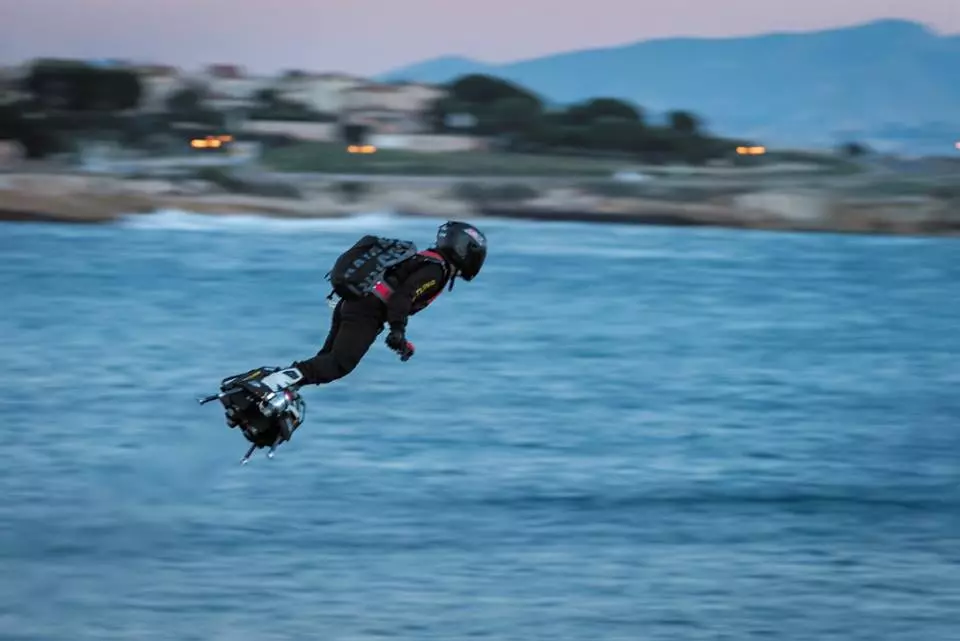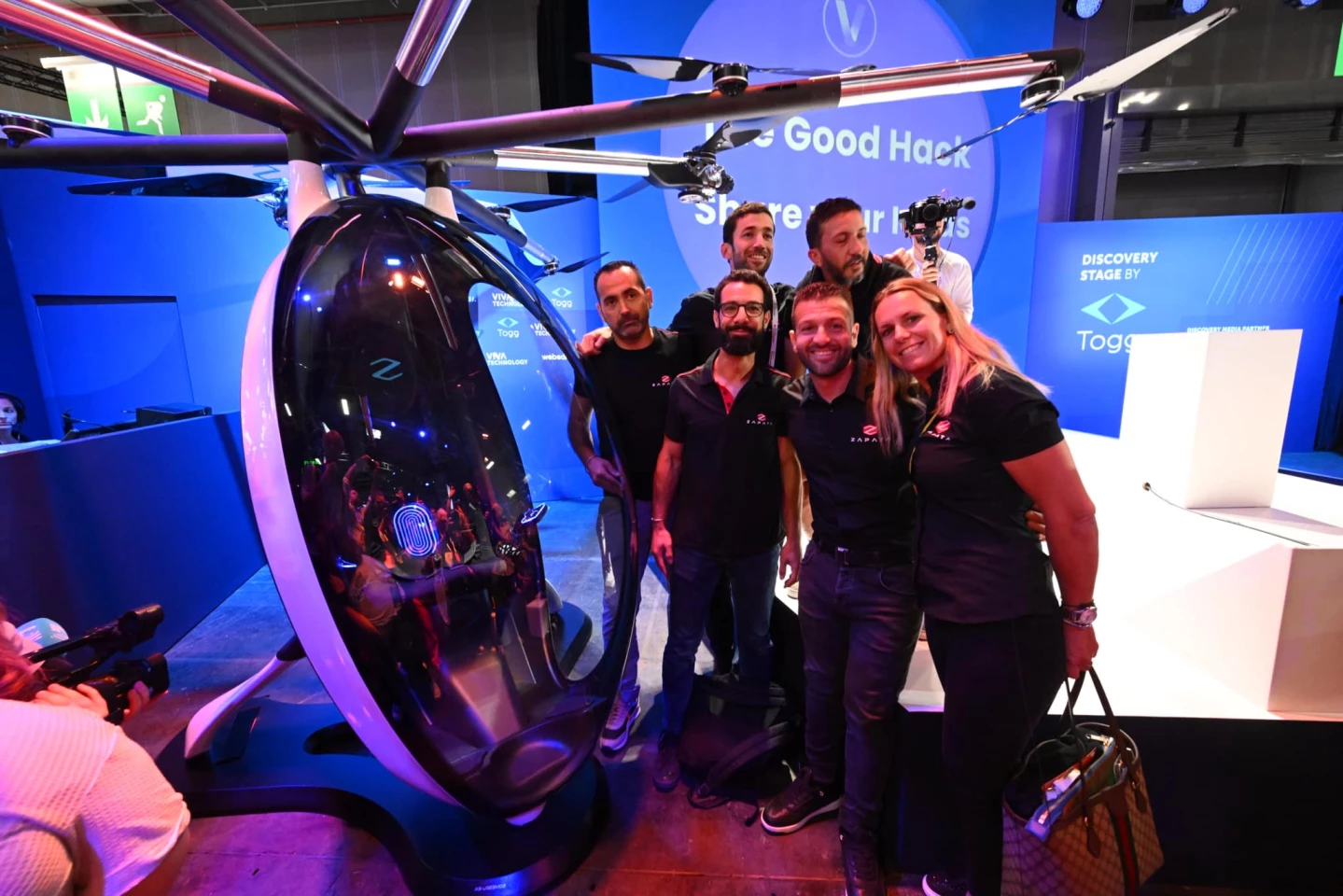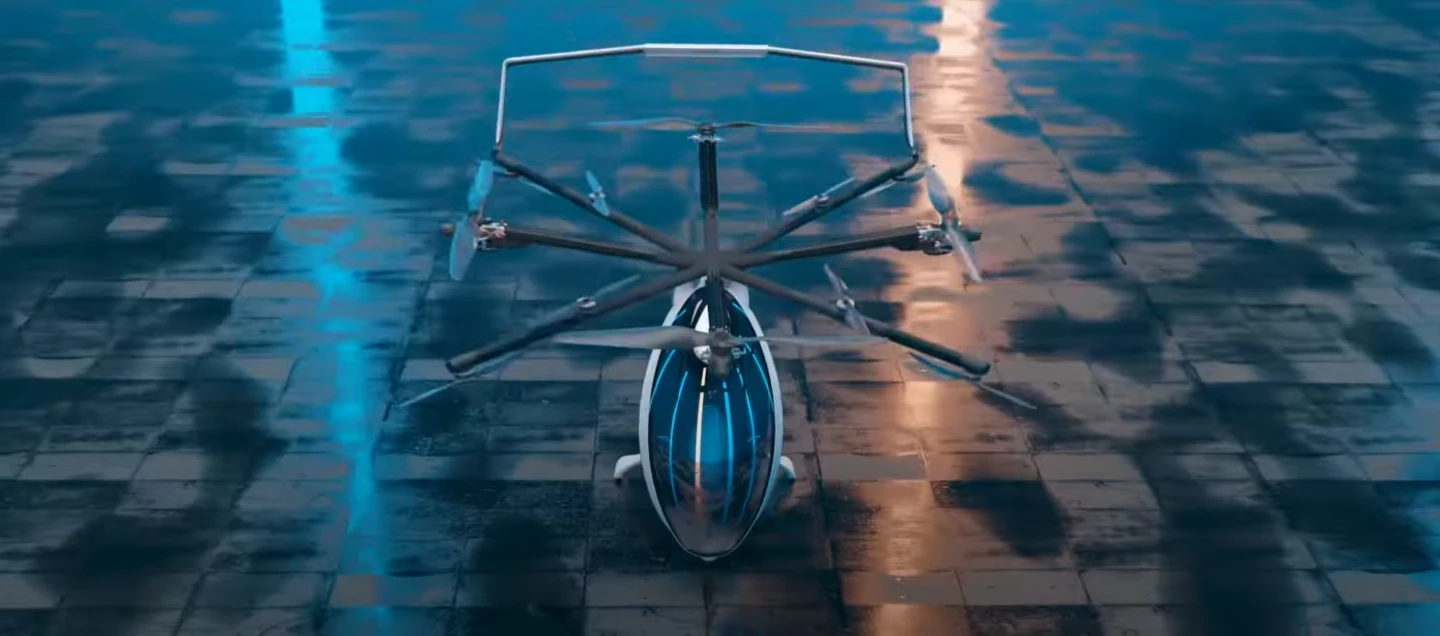One of the most colorful characters in aviation has entered the electric VTOL space. Franky Zapata, best known for his death-defying high-speed Flyboard antics, has announced a hybrid eVTOL to go alongside his jet-powered, flippable flying deckchair.
Zapata's list of innovations is extraordinary. A former French jet ski champion, we first encountered him in 2011, when he stuck some water pipes, ankle and wrist straps to the back of a jet ski and invented the Flyboard, letting people levitate themselves out of the water and do enough tricks to kick off a brand new sport.
By 2016, a new generation of compact, powerful jet turbines had become available, and Zapata wasted little time sticking several of them onto a compact platform with boots bolted to it, then filling a backpack fuel tank with kerosene and taking to the air untethered on what he called the Flyboard Air, leaving the jet ski far below.

Firmly establishing himself among a new pantheon of jet-powered personal flight pioneers that includes jetpack pilot David Mayman, jet suit pilot Richard Browning and jet wing pilot Yves Rossy, Zapata blasted off at jaw-dropping demonstration events all over the world, famously racing a Lamborghini around the Utah desert at speeds over 100 mph (160 km/h), and making the world's first jetboard crossing of the English Channel.
All the while, the Zapata company kept pumping out new inovations: the Zapata EZfly, which gives the Flyboard a pair of handles and makes it possible for inexperienced pilots to get airborne, and the Zapata FlyRide, which takes the original Flyboard watersports concept and turns it into a two-seat "boatercycle" capable of ripping double barrel rolls if you can hang on hard enough.
And more recently, the JetRacer – a flying deckchair, basically, powered by 10 small jet turbines, and capable of speeds up to 250 km/h (155 mph), and altitudes up to 10,000 ft (3,000 m), either with a person on board or with up to 200 kg (441 lb) of cargo under remote control. Oh, and it appears to have a barrel roll button, too. All of the above have been built and flown, with some reaching mass manufacture and others ... well, probably best left to the experts!
Now, Zapata has branched out into an entirely different form of personal flight: the buy'n'fly eVTOL.

The Zapata Airscooter, as it's called, was presented in prototype form at Viva Technology in Paris in June. An egg-shaped pod on legs forms a cocoon for a single seat, and from the top of the pod's roof there are eight carbon poles extending outward. The four longer, diagonal poles each hold what appear to be two electric propellers, with diameters we'd estimate at under a meter (3.3 ft).
The rear two diagonals are connected by a spolier-like wing, angled to provide some lift when this multicopter-style eVTOL is tilted forward and moving at speed. The Airscooter is designed to cruise at 80 km/h (50 mph) and top out at around 100 km/h (62 mph).
On the shorter north, south, east and west poles, there are much larger propellers, maybe double the size. And here's where things get interesting. Zapata promises more than a massive two hours of endurance on this machine, thanks to a hybrid propulsion system.

Most hybrid eVTOLs run a single central generator engine, often a small gas turbine, as a range extender that constantly tops up the battery during flight. But from what we can see, that's not what's going on here. Instead, it seems the four large props are driven by four separate engines, mounted right underneath them at the end of the poles, and fueled through lines running along the tops of the poles.
We can't see much in these renders, but the bit poking out the side of the propulsion unit looks an awful lot like the end of a JetCat-style small helicopter turbine. Indeed, Zapata has partnered with ONERA, the French Aerospace Lab, and the French Defense Agency to develop its own turbine engines, so it's probably an in-house engine. This seems to be driving a belt-linked pair of gears at the bottom, linked through to a similar pair of gears at the top which provide torque to the propeller. We'd assume there's an electric motor underneath all that somewhere too.
If that's what it is, then here's what we assume is going on: those four big props are mainly there to provide bulk thrust, so they'll spin up relatively slowly – albeit possibly with some electric assistance – as the turbines spool up.

The eight smaller, all-electric props will be much quicker to react to power inputs, so we'd assume Zapata is planning to use these to balance the thing in flight, responding to control inputs as well as self-stabilizing commands from the flight control unit that'll help hold it steady as it's blown around by wind.
The benefits of such an arrangement would include long endurance – although we wonder just how long, as compared to a typical single range-extending turbogenerator setup running off the same 18.9 liters (5 gallons) of gasoline. It won't have to carry an enormous, heavy battery pack, and could probably get away with something fairly light. The aircraft has plenty of propellers – enough, you'd think, to safely land it if a turbine or two crapped out.
The drawbacks, on the other hand, are fairly severe. These small turbines, if that's what they are, can be insanely loud. Having four of them surrounding your head ... well, I guess it won't be much worse than having 10 of them surrounding your deckchair on the JetRacer, but it certainly won't be as pleasant a ride as a fully-electric eVTOL.
Then there's maintenance; JetCat USA apparently charges at least US$300 for every 25-hour service on small helicopter turbines. These will be larger and more powerful, and presumably you'll need to get them to a Zapata dealer for service. And of course there's an increased risk of mechanical failure as compared to boring, reliable electric motors – although Zapata, Mayman, Browning and numerous others regularly entrust their lives to these small turbines.
Still, it's an interesting and different approach. And it doesn't need to be fully type certified; weighing just 115 kg (254 lb), the AirScooter qualifies as an ultralight aircraft, meaning that you won't need a pilot's license to fly one in the USA. It'll be as easy as flying a drone, thanks to the fly-by-wire flight controller and plenty of safety sensors presumably ready to stop you from plowing it into a tree.
There's no word yet from Zapata on when this thing will be available, whether the prototype is flying yet, how much they might cost to buy, or indeed how to do so. We assume these things will become clear in time. Meanwhile, check out a short video below.
Source: Zapata








